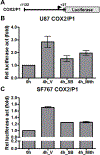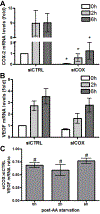Cyclooxygenase-2 Induction by Amino Acid Deprivation Requires p38 Mitogen-Activated Protein Kinase in Human Glioma Cells
- PMID: 28333553
- PMCID: PMC6300144
- DOI: 10.1080/07357907.2017.1292517
Cyclooxygenase-2 Induction by Amino Acid Deprivation Requires p38 Mitogen-Activated Protein Kinase in Human Glioma Cells
Abstract
Glioblastomas (GBMs) are malignant brain tumors that can outstrip nutrient supplies due to rapid growth. Cyclooxygenase-2 (COX-2) has been linked to GBMs and may contribute to their aggressive phenotypes. Amino acid starvation results in COX-2 mRNA and protein induction in multiple human glioma cell lines in a process requiring p38 mitogen-activated protein kinase (p38-MAPK) and the Sp1 transcription factor. Increased vascular endothelial growth factor expression results from starvation-dependent COX-2 induction. These data suggest that COX-2 induction with amino acid deprivation may be a part of the adaptation of glioma cells to these conditions, and potentially alter cellular response to anti-neoplastic therapy.
Keywords: COX-2; Glioblastomas; VEGF; amino acid deprivation; p38-MAPK.
Conflict of interest statement
The authors report no conflicts of interest.
Figures








Similar articles
-
EGFR activation results in enhanced cyclooxygenase-2 expression through p38 mitogen-activated protein kinase-dependent activation of the Sp1/Sp3 transcription factors in human gliomas.Cancer Res. 2007 Jul 1;67(13):6121-9. doi: 10.1158/0008-5472.CAN-07-0141. Cancer Res. 2007. PMID: 17616668
-
Epidermal growth factor-dependent cyclooxygenase-2 induction in gliomas requires protein kinase C-delta.Oncogene. 2009 Mar 19;28(11):1410-20. doi: 10.1038/onc.2008.500. Epub 2009 Jan 26. Oncogene. 2009. PMID: 19169273
-
Activation of p38 MAPK and/or JNK contributes to increased levels of VEGF secretion in human malignant glioma cells.Int J Oncol. 2006 Oct;29(4):981-7. Int J Oncol. 2006. PMID: 16964394
-
Elevated COX-2 Expression Promotes Angiogenesis Through EGFR/p38-MAPK/Sp1-Dependent Signalling in Pancreatic Cancer.Sci Rep. 2017 Mar 28;7(1):470. doi: 10.1038/s41598-017-00288-4. Sci Rep. 2017. PMID: 28352075 Free PMC article.
-
HNE as an inducer of COX-2.Free Radic Biol Med. 2017 Oct;111:169-172. doi: 10.1016/j.freeradbiomed.2017.02.004. Epub 2017 Feb 9. Free Radic Biol Med. 2017. PMID: 28192229 Review.
Cited by
-
p38-Mitogen Activated Kinases Mediate a Developmental Regulatory Response to Amino Acid Depletion and Associated Oxidative Stress in Mouse Blastocyst Embryos.Front Cell Dev Biol. 2019 Nov 8;7:276. doi: 10.3389/fcell.2019.00276. eCollection 2019. Front Cell Dev Biol. 2019. PMID: 31788473 Free PMC article.
-
Harnessing the Co-vulnerabilities of Amino Acid-Restricted Cancers.Cell Metab. 2021 Jan 5;33(1):9-20. doi: 10.1016/j.cmet.2020.12.009. Cell Metab. 2021. PMID: 33406406 Free PMC article. Review.
References
-
- Smith WL; DeWitt DL; Garavito RM Cyclooxygenases: structural, cellular, and molecular biology. Annu Rev Biochem 2000. 69, 145–82. - PubMed
-
- Dandekar DS; Lokeshwar BL Inhibition of cyclooxygenase (COX)-2 expression by Tet-inducible COX-2 antisense cDNA in hormone-refractory prostate cancer significantly slows tumor growth and improves efficacy of chemotherapeutic drugs. Clin Cancer Res 2004. 10, 8037–47. - PubMed
-
- Kishi K; Petersen S; Petersen C; Hunter N; Mason K; Masferrer JL; Tofilon PJ; Milas L Preferential enhancement of tumor radioresponse by a cyclooxygenase-2 inhibitor. Cancer Res 2000. 60, 1326–31. - PubMed
-
- Oshima M; Dinchuk JE; Kargman SL; Oshima H; Hancock B; Kwong E; Trzaskos JM; Evans JF; Taketo MM Suppression of intestinal polyposis in Apc delta716 knockout mice by inhibition of cyclooxygenase 2 (COX-2). Cell 1996. 87, 803–9. - PubMed
MeSH terms
Substances
Grants and funding
LinkOut - more resources
Full Text Sources
Other Literature Sources
Research Materials
